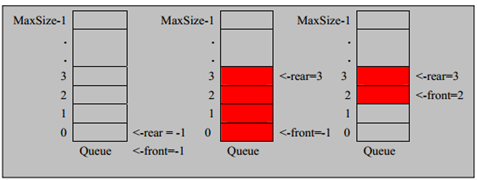数据结构002_队列
队列是个有序列表,可以用数组和链表来实现。
遵循先进先出原则。
只要看后面循环队列就好了。前面普通数组模拟队列太简单了。
使用数组模拟队列:
因为队列输入输出分别是从前后端来处理,所以需要两个变量front和rear分别纪录队列前后点的下标。front会随着数据输出而改变,rear根据数据输入而改变。

数据模拟队列的代码:思路:
1)将尾指针后移rear+1,当front=rear空
2)若尾指针rear小于最大下标maxSize-1,则将数据存入rear所指是数据元素中,否则无法存入数据。rear==maxSize-1队列满。
注意哦:
front 指向队列头部,分析出front是指向队列头的前一个位置.
rear 指向队列尾,指向队列尾的数据(即就是队列最后一个数据)
package com.atguigu.queue; import java.util.Scanner; public class ArrayQueueDemo { public static void main(String[] args) { //测试一把 //创建一个队列 ArrayQueue queue = new ArrayQueue(3); char key = ' '; //接收用户输入 Scanner scanner = new Scanner(System.in);// boolean loop = true; //输出一个菜单 while(loop) { System.out.println("s(show): 显示队列"); System.out.println("e(exit): 退出程序"); System.out.println("a(add): 添加数据到队列"); System.out.println("g(get): 从队列取出数据"); System.out.println("h(head): 查看队列头的数据"); key = scanner.next().charAt(0);//接收一个字符 switch (key) { case 's': queue.showQueue(); break; case 'a': System.out.println("输出一个数"); int value = scanner.nextInt(); queue.addQueue(value); break; case 'g': //取出数据 try { int res = queue.getQueue(); System.out.printf("取出的数据是%d\n", res); } catch (Exception e) { // TODO: handle exception System.out.println(e.getMessage()); } break; case 'h': //查看队列头的数据 try { int res = queue.headQueue(); System.out.printf("队列头的数据是%d\n", res); } catch (Exception e) { // TODO: handle exception System.out.println(e.getMessage()); } break; case 'e': //退出 scanner.close(); loop = false; break; default: break; } } System.out.println("程序退出~~"); } } // 使用数组模拟队列-编写一个ArrayQueue类 class ArrayQueue { private int maxSize; // 表示数组的最大容量 private int front; // 队列头 private int rear; // 队列尾 private int[] arr; // 该数据用于存放数据, 模拟队列 // 创建队列的构造器 public ArrayQueue(int arrMaxSize) { maxSize = arrMaxSize; arr = new int[maxSize]; front = -1; // 指向队列头部,分析出front是指向队列头的前一个位置. rear = -1; // 指向队列尾,指向队列尾的数据(即就是队列最后一个数据) } // 判断队列是否满 public boolean isFull() { return rear == maxSize - 1; } // 判断队列是否为空 public boolean isEmpty() { return rear == front; } // 添加数据到队列 public void addQueue(int n) { // 判断队列是否满 if (isFull()) { System.out.println("队列满,不能加入数据~"); return; } rear++; // 让rear 后移 arr[rear] = n; } // 获取队列的数据, 出队列 public int getQueue() { // 判断队列是否空 if (isEmpty()) { // 通过抛出异常 throw new RuntimeException("队列空,不能取数据"); } front++; // front后移 return arr[front]; } // 显示队列的所有数据 public void showQueue() { // 遍历 if (isEmpty()) { System.out.println("队列空的,没有数据~~"); return; } for (int i = 0; i < arr.length; i++) { System.out.printf("arr[%d]=%d\n", i, arr[i]); } } // 显示队列的头数据, 注意不是取出数据 public int headQueue() { // 判断 if (isEmpty()) { throw new RuntimeException("队列空的,没有数据~~"); } return arr[front + 1]; } }
2.数组模拟环形队列:
为了充分利用数组,可以将数组看成是一个环形的(通过取模的方法就可以实现)。
思路分析:
1)front变量含义做一个调整:指向队列的第一个元素(上面一种是front指向了第一个元素的前一个位置),也就是说arr[front]就是队列的第一个元素。front初始值默认为0。
2)rear也做一个调整:指向队列的最后一个元素的后一个位置,因为希望空出一个空间做约定。rear的初始值也为0。
3)队列满条件是 (rear+1)%maxSize=front;
4)队列空条件是 rear==front;
5)当我们这样分析,队列中有效的数据个数是(rear+maxSize-front)%maxSize。
6)我们就可以在原来的队列上修改得到一个环形队列。
代码:
package com.njcx.test2; import java.util.Scanner; public class CircleArrayDemo { public static void main(String[] args) { CircleArrayQueue queue = new CircleArrayQueue(4); char key = ' '; // 接收用户输入 Scanner scanner = new Scanner(System.in);// boolean loop = true; // 输出一个菜单 while (loop) { System.out.println("s(show): 显示队列"); System.out.println("e(exit): 退出程序"); System.out.println("a(add): 添加数据到队列"); System.out.println("g(get): 从队列取出数据"); System.out.println("h(head): 查看队列头的数据"); key = scanner.next().charAt(0);// 接收一个字符 switch (key) { case 's': queue.showQueue(); break; case 'a': System.out.println("输出一个数"); int value = scanner.nextInt(); queue.addQueue(value); break; case 'g': // 取出数据 try { int res = queue.getQueue(); System.out.printf("取出的数据是%d\n", res); } catch (Exception e) { // TODO: handle exception System.out.println(e.getMessage()); } break; case 'h': // 查看队列头的数据 try { int res = queue.headQueue(); System.out.printf("队列头的数据是%d\n", res); } catch (Exception e) { // TODO: handle exception System.out.println(e.getMessage()); } break; case 'e': // 退出 scanner.close(); loop = false; break; default: break; } } System.out.println("程序退出~~"); } } // 使用数组模拟环形队列 class CircleArrayQueue { private int maxSize; private int front; private int rear; // rear指向数组最后一个元素的下一个位置,预留一个位置作为约定 private int[] arr; // 创建队列的构造器 public CircleArrayQueue(int arrMaxSize) { maxSize = arrMaxSize; arr = new int[maxSize]; front = 0; // front指向数组第一个元素所在的位置 rear = 0; } // 判断队列是否满 public boolean isFull() { return (rear + 1) % maxSize == front; } // 判断队列是否为空 public boolean isEmpty() { return rear == front; } // 添加数据到队列 public void addQueue(int n) { // 判断队列是否满 if (isFull()) { System.out.println("队列满,不能加入数据~"); return; } arr[rear] = n; rear = (rear + 1) % maxSize; // 将rear后移,这里必须考虑取模 } // 获取队列的数据, 出队列 public int getQueue() { // 判断队列是否空 if (isEmpty()) { // 通过抛出异常 throw new RuntimeException("队列空,不能取数据"); } // 这里需要分析出 front是指向队列的第一个元素 // 1. 先把 front 对应的值保留到一个临时变量 // 2. 将 front 后移, 考虑取模 // 3. 将临时保存的变量返回 int n = arr[front]; front = (front + 1) % maxSize; return n; } // 显示队列的所有数据 // 注意了,循环队列少有的脑筋都在这里了哦,重点★ public void showQueue() { if (isEmpty()) { System.out.println("队列空的,没有数据~~"); return; } for (int i = front; i < front + size(); i++) { System.out.printf("arr[%d]=%d\n", i % maxSize, arr[i % maxSize]); } } // 计算队列有效数据的个数 public int size() { // 这里只需要用我们之前总结的公式就好了 return (rear + maxSize - front) % maxSize; } // 显示队列的头数据, 注意不是取出数据 public int headQueue() { // 判断 if (isEmpty()) { throw new RuntimeException("队列空的,没有数据~~"); } return arr[front]; } }



